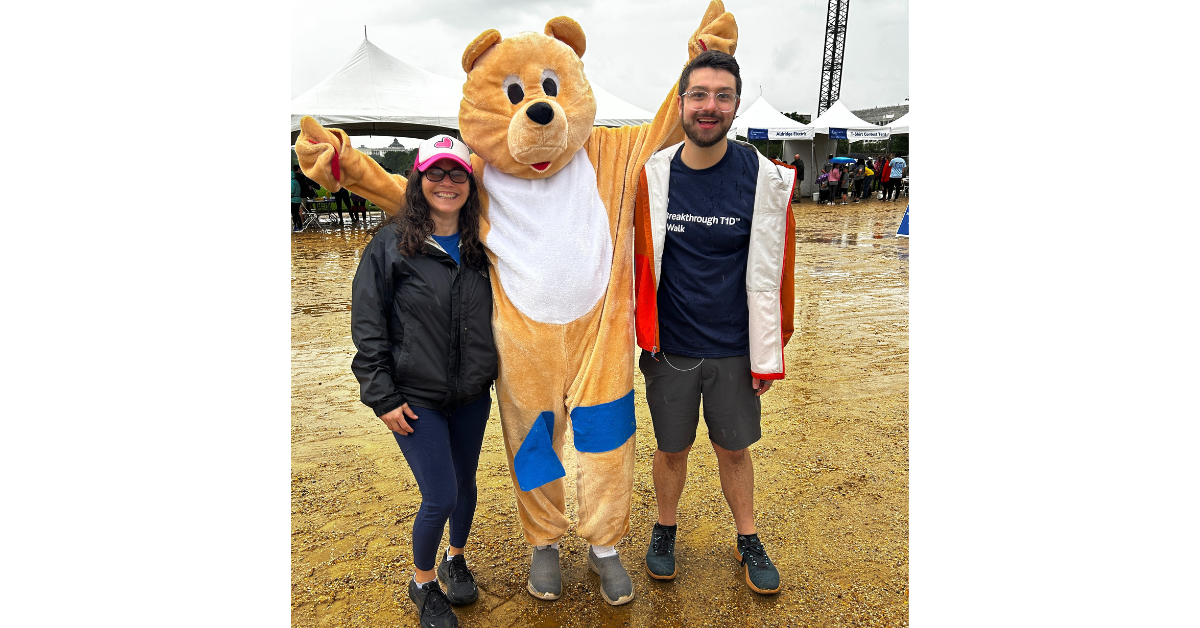Introduction
This weekend, I went to the (rainy!) Breakthrough T1D Walk, and I left with the warm and fuzzy feeling you can only get from community. I met new friends, reconnected with old ones, learned about new pump technologies, and swapped T1D stories. I left feeling proud, connected, and inspired.
But in the middle of all that connection, I noticed something else. There was a moment when my brain got overstimulated and seemingly stopped processing. I’ve learned to name this over time, in what I call sensory overload.
It’s not because I’m upset, not enjoying myself, or not having fun. It’s because my nervous system is overstimulated.
The joy and complexity of community events
Events like the Breakthrough Walk are powerful. They remind us that we’re not alone in navigating life with T1D. They bring people together who get it. But they also bring a lot of sensory inputs, like music, conversations, emotions, beeping technology, and complex thinking. For some of us, that can feel like too much input.
The extra layer of T1D
Sensory overload happens when the brain receives more input than it can effectively process. It’s not about mood or attitude—it’s about how the nervous system is wired. And for those of us managing T1D, the input load is heavier. We’re juggling pump alerts, bolus decisions, mental calculations, emotional responses to blood sugar swings, and fluctuating energy levels. It’s a lot to manage on any given day. So when you layer in conversations, music, movement, and the buzz of a community event, it can bubble over quickly.
What sensory overload feels like
When I hit my threshold, it feels like this:
- Conversations blur into white noise
- Words are said, but don’t land
- My thoughts slow down—or vanish
- I might zone out or seem distracted
It can come off as disinterest or even rudeness. But the truth is: my nervous system is saying, “This is too much.”
What causes it
The triggers aren’t always loud or dramatic. Often it’s a perfect storm of little things:
- Processing too many conversations at once
- Loud music or background noise
- Navigating social interactions
- Thinking about my T1D while making small talk
- Emotional discussions about life with T1D
Even in joyful, meaningful spaces, there’s a threshold. When we cross it, our systems do what they’re designed to do: protect us by slowing down.
Learning to name the experience
My willingness to say it out loud has helped so much. I say something like: “If I seem a bit distracted, I’m having sensory overwhelm in this moment.” Every time I do, I’m met with kindness.
Responses like:
- “Oh, I totally get it, same here.”
- “That makes so much sense.”
- “Me too!”
That’s the magic of naming what’s true. We turn what feels like isolation into connection. And we remind each other that there’s nothing wrong; our brains are just doing their jobs to protect us.
Strategies for soothing an overstimulated nervous system
If you’ve ever felt yourself disconnecting, here are some ways to tend to your nervous system:
- Step outside or into a quieter space
- Excuse yourself from a conversation without guilt
- Lower your sensory input: sunglasses, earplugs, hoodie up
- Check your blood sugar—fluctuations can amplify sensory overload
- Let someone you trust know what’s going on
- Name it out loud: “I’m just feeling a bit overwhelmed.”
None of these are signs of weakness. They’re signs of awareness.
Conclusion
Sensory overload is just your nervous system asking for a little less. The more we learn to honor that voice with compassion, not judgment, the more ease we bring into our lives. So you don’t have to push through or pretend the next time you hit your limit. You can say, “I need a break,” and trust that it’s more than okay.
Naming what’s happening can be incredibly powerful, whether it’s sensory overload, stress, anxiety, or general overwhelm. When we put words to what we’re experiencing and share it with someone else, it often creates just enough space between us and the emotion to help it loosen its grip. Sometimes, that naming alone invites support; other times, just being understood is healing.
Call-to-Action (CTA)
Are you feeling this in your life? Let’s talk about how to create space for your needs without guilt. Book a free consult, and let’s explore what that could look like for you.

be the first to comment